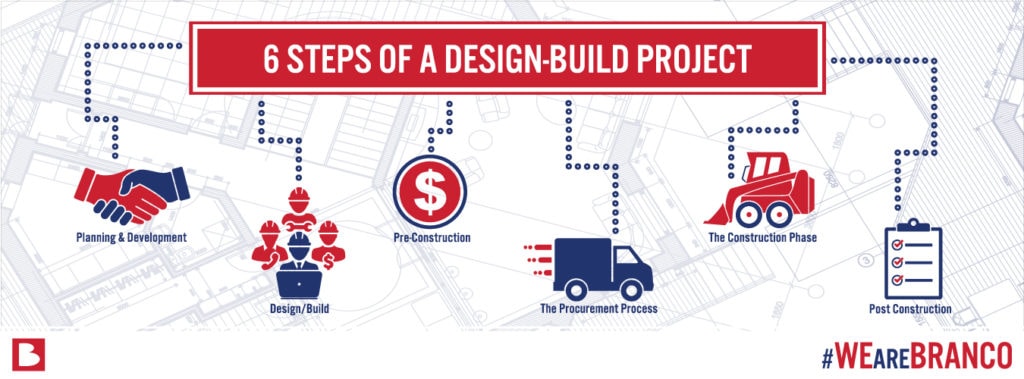What is Design-Build in Construction?
Design-build is a method of project delivery that simplifies the process by allowing the design-build team to work under one contract, directly with the owner, to provide both design and construction services.
This gives owners a single point of contact for both the design and construction of a project and unifies the flow of work from concept to completion. Purposeful collaboration and open communication allow design-build teams to develop creative solutions that result in minimized costs and more efficient scheduling.
This streamline in project delivery has grown popular among many owners because it not only reduces their risk, it allows them to have more flexibility in the approach they choose. Across America, design-build has successfully delivered high-quality churches, office buildings, stadiums, schools and water-infrastructure projects with outstanding results.
It appears that the popularity of design-builds will only continue to rise in future years. Design-Build Institute of America’s market research predicts 18 percent design-build growth by 2021, with fewer traditional low-bid projects and nearly half of the market utilizing design-build.
History of Design-Build
Many people think design-build is a new alternative, modern method of construction, but not only is design-build an instrumental part of the future, it is also part of the past.
Design-build wasn’t given its current name until 1993 and instead went under many other aliases like master builder, master mason, and design and construction, all with the same meaning.
In 40 B.C. Vitruvius, the Roman engineer and architect, wrote the original design handbook that gave a single individual responsibility for both design and construction. From that point forward, design-build was used in many iconic structures including the Parthenon in Athens, the Gothic Royal Abbey Church of Saint Denis in Paris and the Dome of the Florence Cathedral in Italy.
It wasn’t until the Industrial Revolution that these services started to separate because of the need for different specialties for designers working with new, complex facilities. This broke the process of construction and design down into very basic tasks and slowed down construction.
Since then, construction has become more technically demanding and the fields have overlapped once more. Design-build has become extremely popular as more people realize it offers a better way to avoid delays and overruns.
Design-Build Versus Traditional Construction
The biggest difference between design-build and traditional construction is that owners would have to manage two separate contacts—both the contractor and designer. This placed the owner in the middle, making it impossible to settle disputes over cost overruns and delays.
Another form of construction is design-bid-build, also known as general contracting. Within this approach, design and construction are also similarly split by separate contracts and separate work.
With design-build, the owner deals with the design-builder who leads a team of sub-contractors, designers and sub-consultants all under one entity. This means the designer and contractor are on the same team, working towards the same goal.
Process and Phases of Design-Build
The process is broken down into a very exact process. The first step is the initial meeting for the client and the contractor. This meeting allows the client to review the contractor’s qualifications, discuss budget and introduce the industry standards the contractor follows.
After this, there is typically a design meeting to discuss the project goals, style and priorities before the design-build contractor provides a preliminary design drawing and gives a client the chance to make changes and revisions to the plan.
Contractors can then start estimating the cost for the revised plans, prepare construction drawings, and submit the final project estimate based on the final drawings. This gives clients the ability to better manage the loan applications and approvals.
Once the loan and contract are complete, the next step is to apply for a building permit. Before building, the contractor has a pre-construction conference that allows the client to meet the project manager, review details with the project designer and discuss the initial schedule.
The team then works to start site preparation and begin construction. The Project Manager will supervise the project and ensure each trade is performing work according to the exact specifications of the plan.
There are five main phases for design-build. Team members collaborate for each phase, allowing them to overlap and provide rapid project delivery. These phases include;
-
Selecting a design-builder:
Select the design-builder with the best credentials, experience and team. Avoid selecting on bid alone because design-builders evaluate budget solutions early and create continuous price estimates so they can deliver the best value. That’s why it’s important to evaluate both technical concepts and price in the selection process.
-
Pre-construction assessments:
This phase sets the course for a successful project because it includes business and financial assessments that allow the design-build team to learn about your business, current and future facility needs, vision and industry. This gives them the chance to set the scope of your project and come up with creative solutions to achieve goals within budget and time constraints.
-
Architectural design:
Because architects work on the same team and under the same contract, they are able to engineer cost savings into the design. This phase is vital to the rest of the project because it brings key project team members together to form a design that balances the different project needs.
-
Construction:
Your contractor can save time by readying the job site while other phases are progressing. Certain elements can come together while the design phase is still in progress. This moves things along while maintaining the highest quality standards.
-
Post-construction:
Post-construction work allows the owner to have a final walkthrough of the new or renovated facility with the design-builder. This phase should include any training on new aspects of the facility and provide core documentation for the facility’s management team moving forward.
Advantages Created by Design-Build
Design-build saves money and time. Projects are usually delivered on a more compressed timeline, due to the continual communication between the design and construction teams, so fewer delays impact the schedule. Because the two entities are collaborating, they have fewer changes, claims and litigation which makes the project more efficient and lowers costs.
Another big advantage of design-build is the impact it has on owner-risk, because it places sole accountability for results and performance onto the design-build team. This is because all teams operate under one contract.
The work is higher quality because the owner is able to work closely with the design-builder to ensure it meets expectations. This ongoing collaboration equates to fewer gaps throughout the timeline and gives the owner more project control.
Determining if Design-Build is Right for You
Design-build is used on projects big and small. Branco uses design-build services across all industries including education, healthcare and government markets. However; design-build may not be right for every owner or project.
Before deciding to use design-build, consider your expectations for integrating the design and construction phases and what unified needs could be met. If you have a low tolerance for unexpected change orders, prefer to work with an integrated team, and need to get your project done on time, on budget, and to your specifications, then design-build may be your answer.
The experienced design-build team at Branco works with every customer to ensure they get a great facility on time and on budget. Contact our experts today to discuss whether design-build is right for you.


